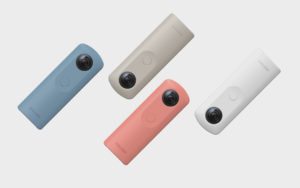
Ricoh Theta V hands-on Back in 2013 Ricoh introduced the Theta, which was the world's first consumer-level 360 camera. Looking like a candy bar with two fisheye lenses bulging out on one end, the Theta was an easy-to-use camera that produced pretty good results.
Now comes the Theta V (pronounced 'vee',) which largely maintains the design of the original model and adds improved image quality, spatial audio recording and, most significantly, 4K video. The Theta V is priced at $429.
Ricoh Theta V hands-on
Ricoh has made a few subtle tweaks to the design of the Theta V compared to its predecessor, the Theta S, which we'll detail on the following slides.
Here's what hasn't changed: You still get the three buttons (power, Wi-Fi and shooting mode) on one side and the main button for taking a photo or video. The Theta V still has two F2 lenses paired with updated 12MP 1/2. 3" sensors (with an effective resolution of 14MP) along with a non-removable li-ion battery. (The Theta arrives at the 14MP output size as each sensor contributes 7MP of original information, with a bit extra from areas that overlap. )
The Theta can be used on its own via the big button on the front (or is it the back?) or can be controlled remotely via the Theta 360 app.
Ricoh Theta V hands-on
You'd never know it by looking at it, but the guts of the Theta V have changed dramatically. It's now Android-based and uses the same Qualcomm Snapdragon 625 processor as many midrange smartphones like the Samsung Galaxy S8. This gives the Theta V an immense amount of processing power, and the use of Android makes the device more extensible than before. Ricoh is promising a firmware update that will speeds up file transfer speeds by doing all the image stitching in the camera (rather than while copying data) while also adding a wireless client mode.
Speaking of faster, the Theta V now has 802. 11ac Wi-Fi, which transfers images 2. 5 times faster than on the Theta S, according to Ricoh. Also new is Bluetooth, which maintains a constant connection between smartphone and camera, which can wake up the Theta even while in sleep mode.
The camera stores photos (up to 4800) and videos (19 mins of 4K) on its 19GB of internal memory, which is up from 8GB on the Theta S.
Ricoh Theta V hands-on
Ricoh has totally revamped audio recording on the Theta V which should increase its appeal to 360 videographers. One of the most frequent issues that comes up in 360 video is how to get viewers to look at things going on behind or to their sides. This is usually done with audio cues, and to address this Ricoh has put four mics on the Theta V: two on the top and one on each side. This allows the 'V' to capture audio both horizontally and vertically. At this time YouTube currently supports spatial audio, while Facebook does not.
Ricoh Theta V hands-on
For higher quality audio capture, Ricoh is offering the TA-1 3D Microphone ($269). Developed by Audio Technica, the mic attaches via the tripod mount and uses a standard 3. 5mm audio jack. Ricoh says that the microphone's large 10mm aperture makes it 'well suited to shooting musical performances. ' A wind screen is included for cutting down on, well, wind noise.
Ricoh Theta V hands-on
To make way for the 3. 5mm audio jack Ricoh sacrificed the micro HDMI port found on earlier Thetas. So how do you view your masterpieces on your television? Miracast.
Miracast is an open standard that is essentially HDMI over Wi-Fi and odds are if you own a connected TV or streaming device like a Google Chromecast or Amazon FireTV Stick*, it'll work. While it's a bit clunky at this time (they seemed to think it'll be better with final firmware), you use the Theta itself as the remote control to navigate through the device's content.
Ricoh has updated its Theta app for iOS and Android, making it easier to get to images and videos you've taken as well as camera settings and shooting modes. Do note that, for whatever reason, the app will continue to be called 'Theta S,' despite compatibility with the new Theta V. A dedicated shutter release button has also been added.
* DPReview. com is a wholly-owned subsidiary of Amazon but dpreview. com is editorially independent of our parent company.
Ricoh Theta V hands-on
Undoubtedly the biggest feature on the Theta V is 4K video capture. One its own, it can capture UHD 4K video (30p) at a bit rate of 56Mbps. If you don't need that much resolution, a 1080/30p mode is also available at a bit rate of 16Mbps. While there's still the expected distortion from the lenses, the quality is a lot better than on previous models in part due to better image processing. The Theta uses the H. 264 codec, though it supports H. 265 for possible use in the future. Spatial audio is recorded in Linear PCM.
The Theta V can also be used for 4K live streaming, via a USB connection to a fast Windows-based PC. In this mode, the bit rate jumps to 120Mbps for 4K and 42Mbps for 1080/30p.
Ricoh Theta V hands-on
New to the Theta V is an optional underwater case, which will set you back $199. This lets you take the Theta for a dip up to 30 meters below sea level. As you can see, all of the important buttons are available while the housing is on.
Based on some quick tests of a non-final Theta V, both stills and videos are noticeably better than those from its predecessor. We're looking forward to getting our hands on a production model in a few weeks and putting it through its paces.
. dpreview.com2017-9-1 15:30







